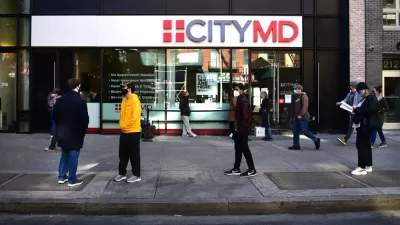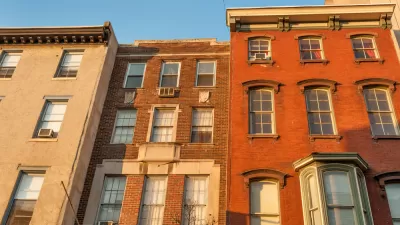A month or two ago, COVID-19 was primarily a Northeastern problem. Is that still the case?

The conventional wisdom in some circles seems to be that in the United States, COVID-19 is primarily a problem for dense Northeastern metro areas, and that the South should get back to work. For example, a recent New York Times headline screamed: "The Coronavirus Is Deadliest Where Democrats Live." And if you look at overall infection and fatality rates from Day One of the epidemic, this view obviously makes sense. As the Times story points out, New Jersey has had ten times as many deaths per capita as Alabama, and in Texas, even the state's largest urban counties have suffered far less than their counterparts in the North.
But a look at infection trends—that is, what states have suffered the most in recent weeks—shows a more complex story. The Washington Post has a daily set of tables and charts, and its data show that the states that originally suffered the most have been flattening the infection curve far more successfully than some other states. For example, let's compare New York state and Texas. On April 15, New York had 11,571 newly reported cases of COVID-19 and 1033 new deaths. On that same day, Texas had 868 new cases and 46 new deaths. In other words, New York had 13 times as many new infections and 21 times as many new deaths as Texas. By contrast, on May 30, New York had 1376 new cases and 55 new deaths, while Texas had 1332 cases and 22 deaths. Infections in Texas actually increased; while deaths decreased, they did not decrease as rapidly as in New York. In other words, New York and Texas converged: they have about the same number of infections, and the New York/Texas "death ratio" nosedived from 21:1 to 2.5:1.
A comparison of New York to other big Southern states shows a similar picture: dramatic improvement in New York, modest improvement in the South. On April 15, New York had about twelve times as many cases as Florida (11,571/891) and over twenty times as many deaths (1033/43). On May 30, New York had less than twice as many of each (1376 cases to Florida's 927. and 55 deaths to Florida's 34). And on April 15, New York had 16 times as many new cases as Georgia (11,571 to 682) and almost 20 times as many new deaths (1033/52). By May 30, New York had slightly under three times as many cases (1376/468) and deaths (55/20).
Western states generally have suffered less than either the Northeast or the South, but the situation in some Western states is actually deteriorating. On April 15, New York had over 70 times as many cases as Arizona (11,571/156) and almost 100 times as many deaths (1033/11). On May 30, New York had less than twice as many new cases (1376/790) and less than three times as many new deaths (55/19). In Colorado, infections actually increased from 339 in mid-April to 485 on May 30, although the number of deaths decreased (from 28 to 7). The growth of the epidemic in the West is not limited to thinly populated states dominated by sprawling cities: in denser California, as in Arizona, infections are increasing. On April 15, New York had almost ten times as many new cases as California (11,571/1086) and about sixteen times as many deaths (1033/63). On May 30, California had more new cases (2992) and more new deaths (88) than New York.
What about the other urbanized Northeastern blue states? Are they more like New York or more like California? In Massachusetts, new cases have decreased by just over half, from 1755 on April 15 to 789 on May 30—a far less rapid decrease than New York, but a more rapid decrease than any of the other states mentioned above. Similarly, new deaths went down from 151 on April 15 to 50 on May 30—again, a less rapid decrease than New York but a more rapid decrease than major Sun Belt states. The results in New Jersey are similar: new cases decreased by almost 2/3 (from 2206 to 764) between April 15 and May 1, and new deaths decreased from 351 to 103.
One obvious (to me) question is: why? Some possible explanations are: 1) Sun Belt states have been quickest to reopen and thus quickest to experience upsurges in infection; 2) weather patterns somehow play a role; and 3) the infection simply happened first in New York, so it was inevitable that as COVID-19 spread across the United States, other states would catch up with New York. More research is needed, and no doubt there will be plenty of it.*
Another question one might ask is: so what? If COVID-19 is spreading faster in the Southwest than in the Northeast, does this have any policy consequences? It seems to me the answer is yes. One argument against any aggressive COVID-19 policy (whether it be continued shutdowns or moving towards a "test and trace" model focused on isolating the infected) is that this virus is only a problem for a few cold, dense Northern cities. But as the gap between those cities and Sunbelt metro areas narrows, this argument becomes less plausible.
*In addition, county-by-county research might reveal different patterns; however, this data is a bit harder to find.

Study: Maui’s Plan to Convert Vacation Rentals to Long-Term Housing Could Cause Nearly $1 Billion Economic Loss
The plan would reduce visitor accommodation by 25,% resulting in 1,900 jobs lost.

North Texas Transit Leaders Tout Benefits of TOD for Growing Region
At a summit focused on transit-oriented development, policymakers discussed how North Texas’ expanded light rail system can serve as a tool for economic growth.

Using Old Oil and Gas Wells for Green Energy Storage
Penn State researchers have found that repurposing abandoned oil and gas wells for geothermal-assisted compressed-air energy storage can boost efficiency, reduce environmental risks, and support clean energy and job transitions.

Private Donations Propel Early Restoration of Palisades Playground
Los Angeles has secured over $1.3 million in private funding to restore the Pacific Palisades playground months ahead of schedule, creating a modern, accessible space that supports community healing after recent wildfires.

From Blight to Benefit: Early Results From California’s Equitable Cleanup Program
The Equitable Community Revitalization Grant (ECRG) program is reshaping brownfield redevelopment by prioritizing projects in low-income and environmental justice communities, emphasizing equity, transparency, and community benefits.

Planting Relief: Tackling Las Vegas Heat One Tree at a Time
Nevada Plants, a Las Vegas-based nonprofit, is combating the city’s extreme urban heat by giving away trees to residents in underserved neighborhoods, promoting shade, sustainability, and community health.
Urban Design for Planners 1: Software Tools
This six-course series explores essential urban design concepts using open source software and equips planners with the tools they need to participate fully in the urban design process.
Planning for Universal Design
Learn the tools for implementing Universal Design in planning regulations.
Ascent Environmental
Borough of Carlisle
Institute for Housing and Urban Development Studies (IHS)
City of Grandview
Harvard GSD Executive Education
Toledo-Lucas County Plan Commissions
Salt Lake City
NYU Wagner Graduate School of Public Service






























